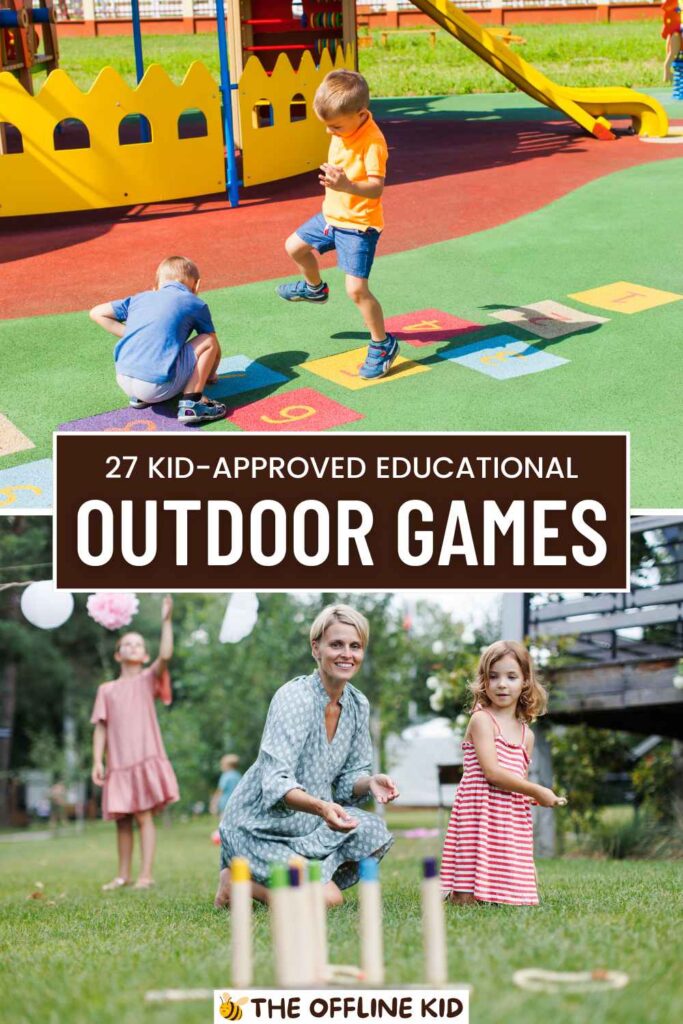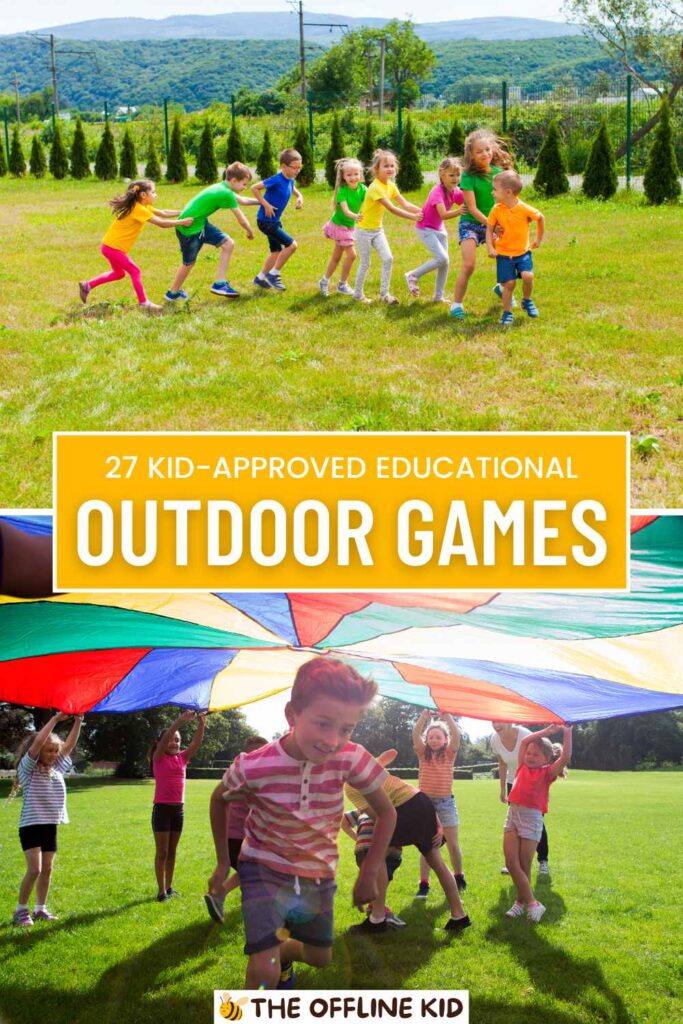Welcome to the ultimate guide for outdoor educational games that blend fun with learning!
Discover 27 engaging activities that will boost your child’s knowledge, creativity, and physical fitness while enjoying the great outdoors.
Nature Exploration Games
Scavenger Hunt
Description and Rules: A scavenger hunt is a classic outdoor game where kids search for specific items in nature. Create a list of objects for children to find, such as a pinecone, a smooth rock, a feather, or a specific type of leaf.
Educational Benefits:
- Observation Skills: Enhances children’s ability to observe and identify different elements in nature.
- Knowledge of Nature: Encourages learning about various plants, animals, and natural objects.
Variations:
- Themed Hunts: Focus on specific themes like colors, shapes, or seasonal items (e.g., autumn leaves).
- Time-Limited Hunts: Add a time limit to increase excitement and challenge.
Nature Bingo
How to Play: Create bingo cards with different natural items or phenomena (e.g., bird, flower, cloud shape). Kids mark off items as they spot them during an outdoor adventure.
Educational Benefits:
- Identification Skills: Helps children learn to identify plants, animals, and natural features.
- Teamwork: Can be played individually or in teams, promoting collaboration and communication.
Printable Resources and Ideas:
- Provide printable bingo cards with various nature items.
- Offer different difficulty levels based on age and knowledge.
Leaf & Rock Identification
How to Collect and Identify: Encourage children to collect different leaves and rocks. Use field guides or mobile apps to help identify them.
Educational Benefits:
- Botany Basics: Introduces children to plant biology and different species of trees.
- Geology Basics: Teaches about different types of rocks and their characteristics.
Tools and Resources Needed:
- Field guides or identification apps
- Magnifying glasses
- Notebooks for recording observations
Bug Hunt
Guidelines for Safe Bug Hunting: Provide nets, jars, and magnifying glasses. Teach children to handle insects gently and return them to their habitats after observation.
Educational Benefits:
- Entomology: Teaches about insect life cycles, habits, and diversity.
- Patience and Observation: Enhances careful observation and respect for living creatures.
Recording Findings and Discussing:
- Encourage children to draw or write about the bugs they find.
- Discuss the roles these insects play in the ecosystem.
Cloud Watching
How to Identify Different Types of Clouds: Teach children the names and characteristics of different clouds, such as cumulus, stratus, and cirrus.
Educational Benefits:
- Meteorology: Introduces basic weather concepts and cloud formation.
- Imagination: Stimulates creative thinking as children imagine shapes and stories in the clouds.
Creative Activities:
- Drawing cloud shapes and writing stories about them.
- Keeping a cloud journal to track different types of clouds seen over time.
Water Cycle Game
Explanation of the Water Cycle Through a Game: Create a game where children act out parts of the water cycle (evaporation, condensation, precipitation, collection).
Educational Benefits:
- Understanding the Water Cycle: Helps children visualize and comprehend the processes involved in the water cycle.
- Teamwork: Encourages cooperation as children work together to complete the cycle.
Materials Needed and Rules:
- Simple props like blue fabric for water, cotton balls for clouds.
- Clear instructions on how to act out each part of the cycle.

Science-Based Games
Bug Hunt
Guidelines for Safe Bug Hunting: Equip children with nets, jars, and magnifying glasses. Emphasize the importance of being gentle and respectful towards insects. Teach them to release bugs back into their natural habitats after observation.
Educational Benefits:
- Entomology: Children learn about insect life cycles, habits, and diversity.
- Patience and Observation: Enhances careful observation skills and instills respect for living creatures.
Recording Findings and Discussing:
- Encourage children to draw or write about the insects they find.
- Facilitate discussions on the roles these insects play in the ecosystem.
Cloud Watching
How to Identify Different Types of Clouds: Educate children on the names and characteristics of various clouds, such as cumulus, stratus, and cirrus.
Educational Benefits:
- Meteorology: Introduces basic weather concepts and cloud formation.
- Imagination: Stimulates creative thinking as children imagine shapes and stories in the clouds.
Creative Activities:
- Drawing cloud shapes and writing stories about them.
- Keeping a cloud journal to track different types of clouds over time.
Water Cycle Game
Explanation of the Water Cycle Through a Game: Create a game where children act out parts of the water cycle (evaporation, condensation, precipitation, collection).
Educational Benefits:
- Understanding the Water Cycle: Helps children visualize and comprehend the processes involved in the water cycle.
- Teamwork: Encourages cooperation as children work together to complete the cycle.
Materials Needed and Rules:
- Simple props like blue fabric for water and cotton balls for clouds.
- Clear instructions on how to act out each part of the cycle.
Solar System Walk
Description and Setup: Set up a scaled-down model of the solar system in an open area. Use objects to represent planets and place them at distances proportional to their actual distances from the sun.
Educational Benefits:
- Astronomy: Teaches children about the relative sizes and distances of planets in the solar system.
- Spatial Awareness: Helps children understand vast distances in space.
Interactive Activities:
- Assign each child a planet to research and present facts.
- Use a flashlight as the sun to demonstrate orbits and rotations.
Plant Growth Experiment
How to Conduct the Experiment: Provide seeds, soil, and containers. Have children plant seeds and track their growth over time. Introduce variables like light, water, and soil type to see how they affect growth.
Educational Benefits:
- Botany: Teaches about plant biology, growth cycles, and environmental factors affecting growth.
- Scientific Method: Encourages hypothesis formation, observation, and recording data.
Tools and Resources Needed:
- Seeds (e.g., beans or sunflowers)
- Soil and containers
- Journals for recording observations
DIY Weather Station
How to Build Simple Weather Instruments: Guide children in making basic weather instruments like a rain gauge, thermometer, and wind vane using everyday materials.
Educational Benefits:
- Meteorology: Provides hands-on learning about weather patterns and measurement techniques.
- Engineering Skills: Encourages creativity and problem-solving in building instruments.
Materials Needed and Instructions:
- Instructions for making a rain gauge (e.g., using a plastic bottle), a simple thermometer (e.g., using rubbing alcohol and a straw), and a wind vane (e.g., using cardboard and a pencil).
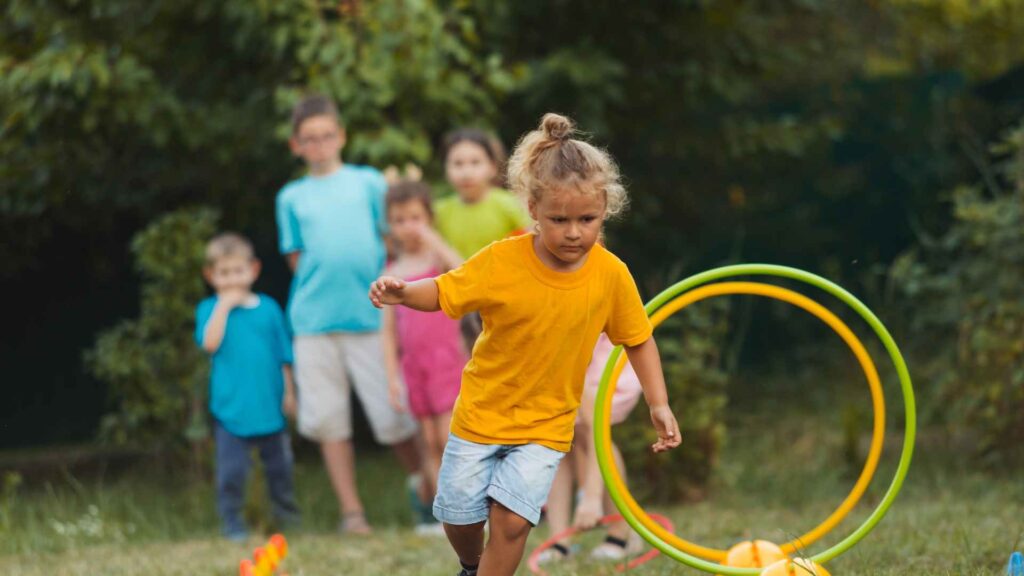
Math and Logic Games
Math Relay
Combining Physical Activity with Math Problems: Set up a relay race where children run to different stations to solve math problems before moving to the next one.
Educational Benefits:
- Math Skills: Reinforces arithmetic, multiplication, division, or other math concepts.
- Physical Exercise: Encourages physical activity, improving overall fitness.
Variations for Different Age Groups:
- Younger Kids: Simple addition and subtraction problems.
- Older Kids: More complex problems like multiplication, division, or fractions.
Shapes in Nature
Finding Geometric Shapes in Natural Surroundings: Encourage children to look for and identify geometric shapes in nature, such as circles in tree rings, triangles in leaf structures, and rectangles in stones.
Educational Benefits:
- Geometry: Helps children understand geometric shapes and their properties.
- Spatial Awareness: Enhances the ability to recognize shapes in different contexts.
Ideas for Expanding the Game:
- Shape Drawing: Have children draw the shapes they find.
- Shape Collage: Collect items and create a collage based on different geometric shapes.
Outdoor Sudoku
Creating a Large-Scale Sudoku Grid Using Natural Materials: Use sticks, stones, and leaves to create a large Sudoku grid on the ground. Fill in some squares and let the children complete the puzzle.
Educational Benefits:
- Logic: Improves problem-solving skills and logical thinking.
- Concentration: Enhances focus and patience.
Step-by-Step Setup Instructions:
- Materials Needed: Sticks for the grid, stones or leaves for numbers.
- Setup: Mark out a 9×9 grid, fill in some squares with numbers (or placeholders), and provide guidance as needed.
Nature Measurement
Measuring Objects in Nature: Provide measuring tapes or rulers and ask children to measure various objects, such as the circumference of a tree, the length of a leaf, or the height of a flower.
Educational Benefits:
- Measurement Skills: Teaches children how to measure length, width, and height.
- Comparison and Estimation: Develops skills in estimating and comparing sizes.
Interactive Activities:
- Recording Measurements: Have children record their findings and compare with friends.
- Measurement Challenges: Set challenges like finding the tallest flower or the widest leaf.
Counting and Sorting
Collecting and Sorting Natural Objects: Ask children to collect items such as pebbles, leaves, or acorns, and then sort them based on different criteria like size, color, or type.
Educational Benefits:
- Counting Skills: Reinforces basic counting skills.
- Categorization: Teaches sorting and categorization, enhancing analytical skills.
Fun Twists to the Game:
- Competitive Sorting: Time the sorting process to make it competitive.
- Graphing: Create simple graphs to represent the quantities of each category.
Math Trails
Creating a Math Trail with Questions and Problems: Design a trail with math problems or questions at various points. Children solve the problems to continue along the trail.
Educational Benefits:
- Math Application: Applies math skills in a real-world setting.
- Problem Solving: Encourages critical thinking and problem-solving.
How to Create a Math Trail:
- Planning the Trail: Select a route and decide on the types of math problems.
- Materials Needed: Problem cards, markers for trail points.
- Instructions: Provide clear instructions and a map for the trail.
Language and Literacy Games
Outdoor Storytelling
Group Storytelling with Prompts from Nature: Gather children in a circle and start a story with an opening line inspired by nature (e.g., “Once upon a time, in a forest full of whispering trees…”). Each child adds a sentence to continue the story, incorporating elements they see around them.
Educational Benefits:
- Creativity: Stimulates imagination and creative thinking.
- Language Skills: Enhances vocabulary, grammar, and narrative skills.
Tips for Engaging Children of Different Ages:
- Younger Kids: Use simple prompts and guide them through their parts.
- Older Kids: Allow for more complex plot twists and character development.
Alphabet Hunt
Finding Objects that Start with Each Letter of the Alphabet: Challenge children to find objects outdoors that start with each letter of the alphabet, from A to Z.
Educational Benefits:
- Literacy Skills: Reinforces letter recognition and phonics.
- Observation Skills: Enhances attention to detail and observation.
Fun Twists to the Game:
- Timed Challenge: Set a timer to increase the excitement and challenge.
- Themed Alphabet Hunt: Focus on specific themes like plants, animals, or man-made objects.
Nature Journaling
Encouraging Kids to Write and Draw Their Outdoor Observations: Provide journals and art supplies for children to record their observations of nature through writing and drawing.
Educational Benefits:
- Writing Skills: Develops writing and descriptive skills.
- Artistic Expression: Encourages creativity and artistic abilities.
Suggested Prompts and Journal Ideas:
- Daily Observations: Have children write or draw what they see each day.
- Seasonal Changes: Record changes in nature throughout different seasons.
- Creative Stories: Encourage children to write stories based on their observations.
Word Treasure Hunt
Creating Clues and Riddles Leading to Hidden Words: Hide words or letters around a designated outdoor area and provide clues or riddles to help children find them.
Educational Benefits:
- Problem-Solving: Develops critical thinking and problem-solving skills.
- Reading Skills: Enhances reading comprehension and vocabulary.
Materials Needed and Setup:
- Clues and Riddles: Create fun and challenging clues.
- Hidden Words: Use laminated cards or write on natural objects like stones.
Outdoor Spelling Bee
Organizing a Spelling Competition in Nature: Set up an outdoor spelling bee where children take turns spelling words related to nature and the outdoors.
Educational Benefits:
- Spelling Skills: Reinforces correct spelling and pronunciation.
- Confidence: Builds confidence in public speaking and performance.
Guidelines and Word Lists:
- Word Difficulty: Adjust the difficulty based on age and skill level.
- Nature-Themed Words: Use words related to plants, animals, weather, and more.
Poetry in the Park
Writing Nature-Inspired Poems: Encourage children to write poems inspired by their surroundings. Provide different types of poetry formats, such as haikus, acrostics, or free verse.
Educational Benefits:
- Creative Writing: Enhances creative writing and literary skills.
- Emotional Expression: Provides an outlet for emotional and sensory expression.
Activities to Enhance Poetry Writing:
- Reading Sessions: Have children read their poems aloud to the group.
- Poetry Walks: Take a walk and write down sensory experiences to inspire poems.
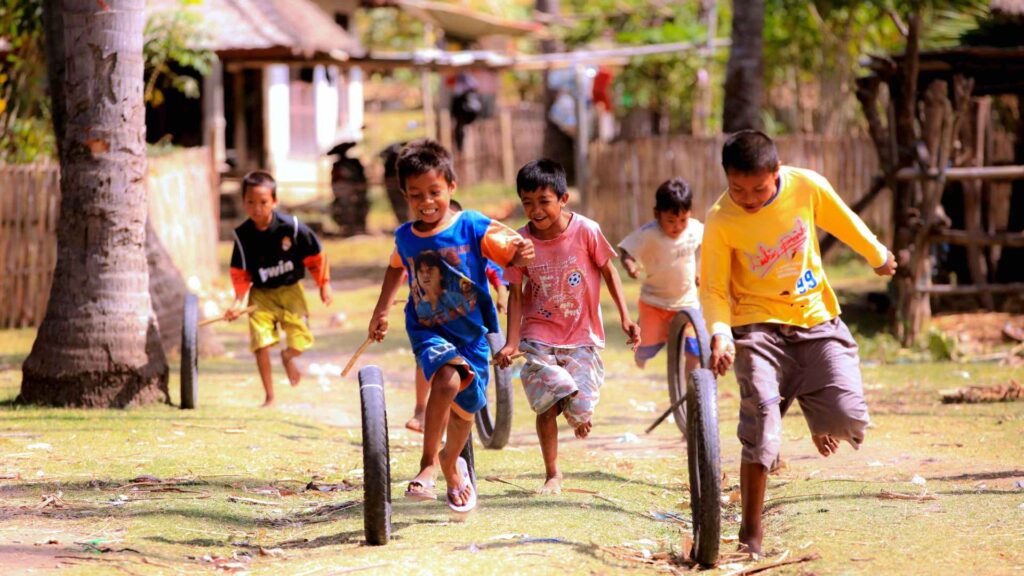
Historical and Cultural Games
Historical Reenactments
Acting Out Historical Events or Daily Life in Past Times: Organize a reenactment where children act out significant historical events or everyday life from a particular historical period. Provide simple costumes and props to make the experience more immersive.
Educational Benefits:
- History Knowledge: Helps children learn about historical events, cultures, and daily life.
- Empathy: Encourages understanding and empathy by stepping into the shoes of people from the past.
Costume and Prop Ideas:
- Costumes: Simple tunics, hats, or aprons representing different historical periods.
- Props: Items like wooden spoons, baskets, or toy swords.
Traditional Indigenous Games
Learning and Playing Games from Different Cultures: Introduce children to traditional games from various indigenous cultures, explaining their historical and cultural significance.
Educational Benefits:
- Cultural Awareness: Promotes understanding and appreciation of diverse cultures.
- Physical Activity: Encourages physical exercise and skill development.
Examples of Games and How to Play Them:
- Stickball: A traditional game similar to lacrosse, originally played by Native American tribes.
- Pukana: A Māori game involving a variety of physical challenges and team activities.
Time Capsule Creation
Making and Burying a Time Capsule to Be Opened in the Future: Have children collect items that represent their current life and interests, place them in a container, and bury it to be opened at a later date.
Educational Benefits:
- Understanding History: Helps children understand the concept of history and the passage of time.
- Future Planning: Encourages thinking about the future and what it might hold.
Steps for Creating a Time Capsule:
- Collect Items: Choose meaningful items like photos, letters, or small toys.
- Prepare the Capsule: Use a waterproof container to protect items from the elements.
- Bury and Mark the Spot: Choose a safe location and mark it with a stone or plaque.
Archaeological Dig
Simulating an Archaeological Dig to Discover “Ancient” Artifacts: Set up a designated dig site with buried “artifacts” like pottery shards, fossils, or coins. Provide tools like small shovels and brushes for children to excavate.
Educational Benefits:
- Archaeology: Introduces children to the methods and importance of archaeology.
- Historical Curiosity: Encourages interest in ancient civilizations and history.
Tools and Setup Instructions:
- Tools: Small shovels, brushes, and sifting screens.
- Setup: Bury items in a sandbox or designated area, mark the site, and provide instructions.
Cultural Story Circles
Sharing Stories from Different Cultures: Gather children in a circle and share traditional stories or myths from various cultures. Encourage them to retell or act out the stories.
Educational Benefits:
- Cultural Literacy: Enhances knowledge of different cultural traditions and stories.
- Storytelling Skills: Improves listening and narrative skills.
Story Ideas and Resources:
- Books and Online Resources: Use storybooks or online resources to find traditional tales.
- Interactive Storytelling: Encourage children to add their own twists or act out scenes.
History Scavenger Hunt
Finding Clues Related to Historical Facts or Events: Create a scavenger hunt with clues leading to information about historical facts, events, or figures.
Educational Benefits:
- Historical Knowledge: Reinforces learning about history in an interactive way.
- Critical Thinking: Develops problem-solving and critical thinking skills.
Clue Ideas and Setup:
- Clues: Use trivia questions, riddles, or puzzles related to historical events.
- Setup: Place clues in different locations, each leading to the next until the final historical fact is revealed.
Physical Education and Team-Building Games
Obstacle Course
Designing and Navigating an Outdoor Obstacle Course: Set up an obstacle course using natural and simple materials like cones, ropes, logs, and hula hoops. Challenge children to navigate the course as quickly and efficiently as possible.
Educational Benefits:
- Physical Fitness: Enhances strength, coordination, and overall physical fitness.
- Problem-Solving: Encourages strategic thinking and problem-solving.
Safety Tips and Course Ideas:
- Safety Tips: Ensure all obstacles are safe and age-appropriate. Supervise children closely.
- Course Ideas: Incorporate different challenges such as crawling under ropes, balancing on logs, jumping over cones, and running through hula hoops.
Team Sports with a Twist
Variations of Traditional Sports with Educational Elements: Modify traditional sports to include educational tasks or challenges. For example, in math soccer, players must solve a math problem before taking a shot on goal.
Educational Benefits:
- Teamwork: Promotes collaboration and communication.
- Strategy: Encourages strategic thinking and planning.
Examples:
- Math Soccer: Solve math problems to earn points before scoring goals.
- Science Baseball: Answer science trivia questions correctly to advance bases.
Fitness Scavenger Hunt
Combining Physical Challenges with a Scavenger Hunt: Create a scavenger hunt that includes physical challenges at each stop. For example, do 10 jumping jacks before finding the next clue.
Educational Benefits:
- Physical Fitness: Promotes cardiovascular health and physical endurance.
- Teamwork: Encourages collaboration and problem-solving.
Challenge Ideas and Rules:
- Challenges: Include activities like jumping jacks, squats, sprints, or balance exercises.
- Rules: Set clear rules for completing physical challenges before moving to the next clue.
Capture the Flag
Classic Team Game with Strategic Elements: Divide children into two teams, each with a flag to protect while trying to capture the opposing team’s flag.
Educational Benefits:
- Teamwork: Encourages cooperation and teamwork.
- Strategy: Develops planning and strategic thinking.
Game Setup and Variations:
- Setup: Define boundaries and safe zones. Place flags in well-marked locations.
- Variations: Add obstacles, use multiple flags, or incorporate educational questions to earn the right to capture the flag.
Tug-of-War
Strength and Team Coordination Game: Set up a tug-of-war rope with a marked center point. Teams pull the rope to bring the center point over their designated line.
Educational Benefits:
- Strength: Builds physical strength and endurance.
- Team Coordination: Enhances communication and coordination within teams.
Safety and Fair Play Tips:
- Safety Tips: Ensure the ground is clear of hazards. Supervise closely to prevent injuries.
- Fair Play: Encourage good sportsmanship and fair play.
Relay Races with Educational Tasks
Combining Relay Races with Learning Challenges: Design relay races where children must complete educational tasks, such as spelling a word or solving a math problem, before passing the baton to the next runner.
Educational Benefits:
- Physical Fitness: Promotes running and physical activity.
- Cognitive Skills: Reinforces learning through physical challenges.
Examples and Instructions:
- Spelling Relay: Spell a word using letter cards before running to the next station.
- Math Relay: Solve a math problem at each station before advancing.
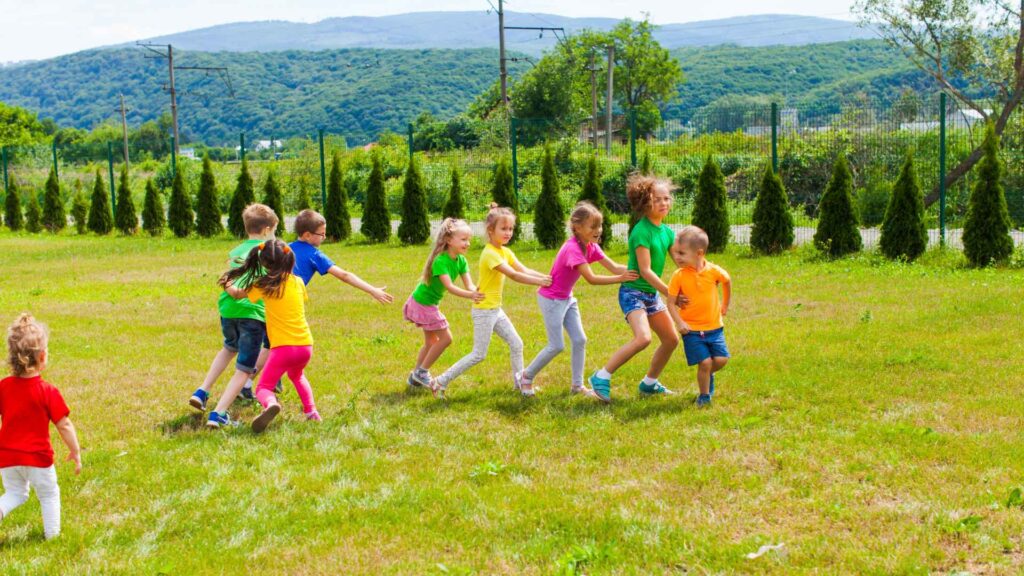
Artistic and Creative Games
Nature Art
Creating Art Using Natural Materials: Encourage children to collect leaves, sticks, rocks, and flowers to create art projects. They can arrange these materials into patterns, make collages, or create sculptures.
Educational Benefits:
- Creativity: Stimulates artistic expression and creativity.
- Environmental Awareness: Promotes appreciation and respect for nature.
Project Ideas:
- Leaf Rubbings: Place leaves under paper and rub with crayons to create textured art.
- Rock Painting: Paint positive messages or designs on rocks to decorate the garden.
Outdoor Music Making
Using Natural Materials to Create Instruments and Sounds: Guide children in making simple musical instruments from natural materials, such as creating a rainstick from a hollow branch and pebbles, or a drum from a large log.
Educational Benefits:
- Music: Introduces basic concepts of rhythm, sound, and musical creativity.
- Creativity: Encourages innovative thinking and problem-solving.
Examples and Instructions:
- Rainstick: Use a hollow branch, seal both ends, and fill with small pebbles or beans.
- Wind Chimes: Tie together shells, sticks, and other items that create sound when the wind blows.
Environmental Sculpture
Building Sculptures from Found Objects in Nature: Have children collect natural objects to build sculptures. They can create animals, abstract shapes, or even miniature villages.
Educational Benefits:
- Art: Enhances artistic skills and spatial awareness.
- Environmental Stewardship: Encourages recycling and reusing materials.
Ideas for Sculptures and Materials:
- Animal Sculptures: Use sticks and leaves to create animal shapes.
- Miniature Villages: Build small houses and structures using rocks, twigs, and leaves.
Nature Mandalas
Creating Mandalas with Natural Objects: Teach children to create mandalas, circular designs, using pebbles, leaves, flowers, and other natural items.
Educational Benefits:
- Art: Develops symmetry, pattern recognition, and fine motor skills.
- Mindfulness: Promotes relaxation and concentration.
Instructions and Ideas:
- Center Point: Start with a central object and work outward in concentric circles.
- Pattern Creation: Use repetition and symmetry to create intricate designs.
Shadow Art
Using Natural Light and Shadows to Create Art: Have children use natural light and shadows to create art. They can trace shadows of objects or use their bodies to make shadow shapes on large sheets of paper.
Educational Benefits:
- Science: Introduces basic concepts of light and shadows.
- Art: Encourages creative thinking and observation.
Materials and Setup:
- Materials: Large sheets of paper, pencils, or chalk.
- Setup: Position objects in the sunlight to create shadows, then trace and decorate the outlines.
Nature Weaving
Weaving with Natural Materials: Provide simple looms made from branches and teach children to weave using grass, leaves, and flowers.
Educational Benefits:
- Art: Develops fine motor skills and artistic expression.
- Cultural Awareness: Introduces traditional weaving techniques and cultural significance.
How to Create a Loom and Weave:
- Materials: Branches, string, and natural materials for weaving.
- Instructions: Create a simple loom by tying branches together. Weave grass, leaves, or flowers through the strings.
Environmental Stewardship Games
Eco-Friendly Scavenger Hunt
Finding and Learning About Eco-Friendly Practices and Items: Design a scavenger hunt where children look for items and practices that promote environmental sustainability, such as recycling bins, compost piles, solar panels, and reusable water bottles.
Educational Benefits:
- Environmental Awareness: Teaches children about eco-friendly practices and sustainability.
- Responsibility: Encourages responsible behavior towards the environment.
Example Items and Practices to Include:
- Recyclable Items: Find objects that can be recycled, such as plastic bottles or paper.
- Sustainable Practices: Look for examples like compost bins, solar panels, and water-saving devices.
Clean-Up Relay
Competing in Teams to Pick Up Trash and Clean Up an Area: Organize a relay race where children compete in teams to pick up trash and clean up a designated outdoor area. Provide gloves and bags for collecting litter.
Educational Benefits:
- Environmental Stewardship: Instills a sense of responsibility for keeping the environment clean.
- Teamwork: Promotes collaboration and teamwork.
Rules and Safety Tips:
- Rules: Set boundaries for the clean-up area and establish a time limit.
- Safety Tips: Ensure children wear gloves and supervise to avoid hazardous items.
Recycling Sorting Race
Sorting Items into Recycling Categories as a Race: Set up bins for different recycling categories (paper, plastic, metal, glass) and have children race to sort a pile of mixed recyclables into the correct bins.
Educational Benefits:
- Recycling Knowledge: Teaches children about the importance and process of recycling.
- Speed and Accuracy: Develops quick thinking and accuracy in sorting items.
Setup and Rules:
- Materials Needed: Bins labeled for each recycling category, mixed recyclables.
- Instructions: Explain the different categories and rules for sorting. Start the race and monitor for accuracy.
Planting Trees or Gardens
Involving Children in Planting Trees or Creating Gardens: Organize a tree-planting or garden-making activity where children can plant trees, flowers, or vegetables. Teach them how to care for the plants.
Educational Benefits:
- Botany and Gardening: Introduces basic concepts of plant biology and gardening.
- Environmental Stewardship: Encourages care for the environment and sustainable practices.
Steps for Planting:
- Preparation: Select appropriate plants or trees for the area. Provide necessary tools and materials.
- Planting: Teach children how to plant and care for the trees or garden.
Water Conservation Games
Activities Focused on Saving Water: Create games and activities that emphasize the importance of water conservation, such as water relay races with minimal water usage or challenges to find and fix “leaks” (simulated with small holes in containers).
Educational Benefits:
- Water Conservation: Raises awareness about the importance of conserving water.
- Problem-Solving: Encourages creative solutions for saving water.
Examples and Instructions:
- Water Relay: Use small cups to transfer water, emphasizing minimal spillage.
- Leak Fixing Challenge: Use containers with small holes and challenge children to find and fix the leaks using tape or other materials.
Wildlife Habitat Creation
Building Habitats for Local Wildlife: Guide children in creating habitats for local wildlife, such as birdhouses, bat boxes, or insect hotels.
Educational Benefits:
- Wildlife Conservation: Teaches about local wildlife and the importance of providing safe habitats.
- Construction Skills: Develops basic building and construction skills.
Project Ideas and Instructions:
- Birdhouses: Build simple birdhouses using wood and nails.
- Insect Hotels: Create insect hotels using bamboo, pinecones, and other natural materials.
STEM Games
Outdoor Coding Game
Creating a Human Coding Game with Nature Elements: Design a game where children act as “robots” following coded instructions using natural elements like sticks, stones, or leaves as markers for different commands.
Educational Benefits:
- Coding Principles: Introduces basic concepts of coding and programming.
- Teamwork: Encourages cooperation and communication.
Instructions and Variations:
- Basic Commands: Use simple instructions like “move forward,” “turn left,” “pick up leaf.”
- Advanced Challenges: Incorporate loops and conditionals for older children.
Build a Weather Station
Constructing Simple Weather Instruments and Recording Data: Guide children in building basic weather instruments like a rain gauge, thermometer, and wind vane using everyday materials. Track and record weather data over time.
Educational Benefits:
- Meteorology: Teaches about weather patterns and measurement techniques.
- Hands-On Learning: Encourages practical application of scientific principles.
Steps and Materials Needed:
- Rain Gauge: Use a plastic bottle marked with measurement lines.
- Thermometer: Create a simple thermometer using rubbing alcohol and a straw.
- Wind Vane: Construct a wind vane with cardboard, a pencil, and a pin.
Rocket Launch
Building and Launching Simple Rockets Using Safe Materials: Organize a project where children build rockets using materials like baking soda and vinegar or compressed air. Launch the rockets in an open outdoor space.
Educational Benefits:
- Physics: Introduces principles of aerodynamics and propulsion.
- Engineering: Develops engineering and problem-solving skills.
Instructions and Safety Considerations:
- Materials: Baking soda, vinegar, plastic bottles, corks.
- Setup: Ensure a safe launch area and provide clear instructions for assembly and launch.
Solar Oven Experiment
Creating a Solar Oven to Cook Simple Snacks: Help children build a solar oven using a cardboard box, aluminum foil, and plastic wrap. Use the oven to cook simple snacks like s’mores or hot dogs.
Educational Benefits:
- Solar Energy: Teaches about renewable energy and solar power.
- Scientific Method: Encourages hypothesis formation, experimentation, and observation.
Materials and Steps:
- Materials: Cardboard box, aluminum foil, plastic wrap, black construction paper.
- Steps: Line the box with foil, cover with plastic wrap, and place food inside to cook.
Bridge Building Challenge
Designing and Constructing Bridges Using Natural Materials: Challenge children to build strong bridges using sticks, stones, and other natural materials. Test the bridges by placing weights on them to see how much they can hold.
Educational Benefits:
- Engineering: Introduces concepts of structural engineering and design.
- Problem-Solving: Encourages creativity and critical thinking.
Instructions and Materials:
- Materials: Sticks, stones, leaves, string.
- Instructions: Provide basic guidelines for building, then let children experiment with their designs.
Nature-Based Robotics
Creating Simple Robots or Mechanical Devices Using Natural and Recycled Materials: Guide children in building basic robots or mechanical devices using natural and recycled materials. For example, create a wind-powered vehicle using leaves and sticks.
Educational Benefits:
- Robotics: Introduces basic principles of robotics and mechanics.
- Environmental Awareness: Encourages recycling and sustainable practices.
Project Ideas and Instructions:
- Wind-Powered Vehicle: Use a lightweight base, attach leaves as sails, and let the wind move it.
- Simple Robots: Create a basic robot with movable parts using sticks and string.
Conclusion
Recap of the Benefits of Outdoor Educational Games
Outdoor educational games provide a unique blend of fun and learning that stimulates children’s minds and bodies. By engaging in these activities, children can:
- Develop Critical Skills: Enhance their observation, problem-solving, creativity, and teamwork abilities.
- Stay Active: Improve physical fitness through movement and exercise.
- Foster a Love for Nature: Cultivate a deep appreciation and respect for the natural world.
- Learn Through Play: Absorb educational concepts in a hands-on, enjoyable manner.
Encouragement to Mix and Match Games
These 27 outdoor educational games offer a variety of ways to engage children in learning while they play.
Mix and match the games to suit different learning objectives and keep activities fresh and exciting. Tailor the complexity and themes of the games to match the interests and developmental levels of the children involved.
